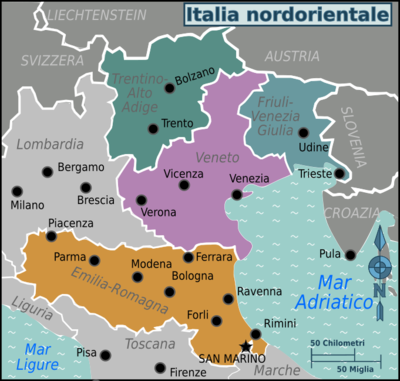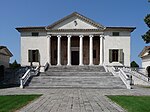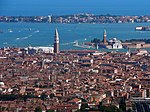| Northeastern Italy | |
 | |
Location  | |
| State | Italy |
|---|---|
| Surface | 62 310 km² |
| Inhabitants | 11.711.149 (2012 census) |
Northeastern Italy is a region ofItaly.
To know
North-Eastern Italy or simply North-East is that part of Italian territory that includes the Tre Venezie or Triveneto (Friuli Venezia Giulia, Trentino Alto Adige is Veneto) and theEmilia Romagna.
Geographical notes
It borders to the north with theAustria and the Switzerland, to the east with the Slovenia, to the south with the Liguria, the Tuscany, the Marche and the Republic of San Marino, to the west with the Lombardy and, for a very short stretch with Piedmont. L'Emilia Romagna, the Friuli Venezia Giulia and the Veneto they are washed by the Adriatic Sea.
North-eastern Italy encompasses most of the Po-Venetian plain, crossed by the Po, the longest river in Italy, and includes highly industrialized regions with a high tourist vocation.
Territories and tourist destinations

Urban centers
.jpg/220px-Duomo_San_Georgio_(Ferrara).jpg)

.jpg/220px-Ravenna,_san_vitale,_giustiniano_e_il_suo_seguito_(prima_metà_del_VI_secolo).jpg)


.jpg/220px-Palazzo_Chiericati_(Vicenza).jpg)
- Bologna - Bologna the erudite, because it is the seat of the oldest and for a long time the most prestigious university in Europe; but also Bologna the fat one, because hunger is not a good ally of the study. Here then the fame of its mortadella and its tortellini goes hand in hand with its cultural traditions, the beauty of its arcades and its monumental streets, of San Petronio and of the Madonna di San Luca which dominates from the top of a hill and watches over the city.
- Ferrara - The city and the Este family are inseparable. The house of Este had Ferrara from the early thirteenth century until the end of the sixteenth century, when it returned to the papal possessions. Such and such was the imprint given to it by the Este, that there is no mention of the long papal period, except to indicate it as a period of its decline. A few industries and a lot of agricultural production are the sources of its economy; good is also the tourist activity in this city of art which reduces its peripheral position a little.
- Padua - It is universally known as the city of Sant'Antonio (of Padua, not from Padua, as is often erroneously said, because he was not Paduan by birth) to which he dedicated an imposing and rich Basilica, which benefits from the spectacular presence of the vast Prato della Valle which gives it a wide range. Its oriental-looking domes recall the Venetian Basilica of San Marco. Then there is a masterpiece of exceptional beauty Scrovegni Chapel, admirably frescoed by Giotto.
- Parma - The city of Parma ham and violet, Maria Luigia and Verdi, Parmigiano Reggiano and the University, the beautiful Romanesque Cathedral and Correggio, the Farnese and Parmigianino, the Bourbons and the Charterhouse of Parma of Stendhalian memory: there are many excellences and beauties, the charm and the myths of this city that still lives as if it were always a capital.
- Ravenna - It is the triumph of Byzantine art in Italy. It was the capital of the Western Roman Empire in the V and VI centuries, then of the Reign of the Ostrogoths and of the Byzantine Exarchate, and has preserved the splendid monuments with which Galla Placidia, Odoacer, Theodoric adorned it. The amazing mosaics of its churches immortalize the art and architecture that marks the moment of transition and mingling between the Byzantine and Roman worlds. Its Christian monumental complex is from 1996 World Heritage. Dante Alighieri died in Ravenna in 1321, of which he preserves the monumental tomb in the shape of a temple.
- Rimini - It is the symbol of holiday at the seaside especially for families with children, but it has also equipped itself with countless fun centers for young people. Begun in the nineteenth century, seaside tourism has found an unstoppable development here, which has made the city spread along the entire coast, with its deep sandy beaches. Rimini has now created a conurbation with the seaside resorts to the north and south of the city, which extends for tens and tens of kilometers.Its historic center, quiet and foreign to the teeming confusion of the modern city, is characterized above all by the Roman Arch of Augustus and from the Malatesta Temple.
- Trento - Its symbol is the Buonconsiglio Castle, the largest and most important monumental complex in the Trentino Alto Adige. It hosted the bishops of Trento from the thirteenth century until the eighteenth century.
- Trieste - Although devoted to Italianness (it strongly pursued its belonging to Italy when in the post-war period it risked being annexed to the then Yugoslavia) it still maintains a character Central European which comes from its long history as a border town (now on one side, now on the other) and as a hinge between the Germanic, Slavic and Latin worlds. Its port is one of the largest in the Adriatic and in Italy; its elegant urban planning, its embrace with the sea and with the mountains behind it make it a destination of great suggestion for artistic and natural beauties.
- Udine - He took over from Aquileia is Cividale, which were the main cities of the region, when the seat of the Patriarchate of Aquileia was transferred to Udine. It was the capital of Homeland of Friuli until the conquest by Venice which left a considerable architectural imprint on it. Monumental is the central Piazza della Libertà, with harmonious buildings. The Castle, built on the site of the castle of the patriarchs of Aquileia, is a massive sixteenth-century building.
- Venice - The city is an architectural mirage that seems to be born like Venus from the foam of the sea. The churches, the palaces, the streets, the squares, the canals, everything is like a dream that has enchanted and enchants millions of tourists from all over the world. Its charm emanates from the silent intimacy of the most secluded streets, enveloped by the lagoon mist that permeates everything with a slight magical melancholy, but also by the glowing splendor of its Carnival that animates the incomparable Piazza San Marco with refined masks.
- Verona - Known throughout the world for being the city of the Shakespearean events of Romeo and Juliet, Verona boasts a monumental heritage of exceptional stature. The Roman Arena, temple of opera, and then the monuments of the Scaligeri lordship (Castelvecchio, San Zeno, Arche Scaligere), the elegance of Renaissance town planning make it one of the most important art cities in northern Italy.
- Vicenza - City of art with refined and elegant urban planning, its monuments are a hymn to the architectural art of the great Palladio who renewed and marked its entire historic center according to the Renaissance canons. Piazza dei Signori in particular is the casket that houses the city's monumental excellences, first of all the Basilica.
Other destinations

.JPG/220px-Bressanone_-_chiostro_del_duomo_(50).JPG)

- Aquileia - It was the ancient capital of the territory corresponding roughly to the current Friuli. Of the Roman and early Christian city there remain very important monuments and vast excavations, which make it a very popular tourist destination.
- Asolo - The name of the city is linked to that of two women: the Queen of Cyprus Caterina Cornaro who held her court there and the actress Eleonora Duse who lived there and wanted to be buried here. It is part of the most beautiful villages in Italy.
- Belluno - Spontaneously given to Venice in 1404, the city retained a certain autonomy for this reason and lived a peaceful existence without political shocks and without wars. Its mountains were precious wood deposits for the shipbuilding industry of the Serenissima.
- Bressanone - City with an important historical center enclosed by walls and gates. The Cathedral, his cloister with precious frescoes, the Bishop's Palace give an elegant imprint to the old city, with characteristic small villages that contrast with wide-ranging urban openings.
- Brunico - Main center of the Val Pusteria, preserves two castles as well as historic districts of good interest. It is a city of tourism at the convergence of the tributary valleys of the Val Pusteria, all characterized by an environment of particular beauty.
- Chioggia - City built on a group of islands in the Venetian Lagoon, has atmospheres, urban planning, profoundly Venetian glimpses, while maintaining its own individuality and its peculiarity character made immortal by Goldoni in the Chiozzotte quarrels.
- cortina d'Ampezzo - Queen of the Venetian Dolomites, it has been an internationally renowned winter and summer tourist resort for decades.
- Feltre - Important city at the foot of the Dolomites, it was municipium Roman. In 1404 he gave himself to Venice, which then followed the fate. Its historic center, beautiful and monumental, is clinging to the Hill of the goats.
- Gorizia - Autonomous county with close relations with Venice, was then inserted in the territories of the Austro-Hungarian Empire. After the Second World War, now Italian, it suffered the detachment of a large part of its territory in favor of the former Yugoslavia, finding itself with some neighborhoods separated by the border between the two states.
- Degree - Formerly a Roman port for the trade of Aquileia, the ancient lagoon city has a very respectable historic center. In contemporary times it has developed an important seaside activity.
- Lake Garda - The largest body of water on the Peninsula and in the Lombardy it offers tourist opportunities of various kinds: climatic stays, even in winter, for the elderly and families, bathing and water sports activities; excursions on the reliefs that surround the lake basin; entertainment for young people in the countless clubs and amusement parks that arise near it also on the shore Venetian.
- Madonna of Campiglio - One of the most famous summer and winter sports resorts in the entire Alpine arc, already renowned in the Habsburg era, when it could boast the frequentation of the Austrian imperial family.
- Montagnana - Walled city, it preserves intact the quadrilateral of walls and the crenellated towers. It has a suggestive historic center that has earned it the entry into the ranks of the most beautiful villages in Italy.
- Palmanova - Fortress city planned by the Venetians in 1593 to defend its borders with the Austrian empire, it is called the starry city for its polygonal star shape with 9 points. It has been a national monument since 1960.
- Rovereto - Second city in Trentino, it is famous for its Bell of the fallen.
- Treviso - Formerly a Roman municipality with the name of Tarvisium, flourished in medieval times and under the rule of the Republic of Venice. The heart of the city is the Piazza dei Signori, around which there are numerous buildings, including the "Bell Tower" and the "Palazzo dei Trecento". Giuseppe Mazzotti defined Treviso "the most frescoed city in Italy".
- Sterzing - It is one of the most beautiful villages in Italy. Its historical core has remained almost intact in its 12th century conformation. Only a few tracts remain of the walls. Characteristic are the houses equipped with details bay windows or Erker, covered and closed projecting balconies.
How to get
How to get around
What see
Northeastern Italy boasts places of world-class artistic, historical and cultural interest, recognized by theUNESCO as part of the World Heritage.
List of world heritage sites in northeastern Italy
Veneto
 | City of Verona - The historic city of Verona was founded in the 1st century BC. It is particularly flourishing under the rule of the Scaligeri in the thirteenth and fourteenth centuries and as part of the Venetian Republic from the fifteenth to the eighteenth century. Verona has preserved a considerable number of monuments from antiquity, the medieval and Renaissance periods, and represents an excellent example of a military stronghold. |
 | City of Vicenza and Palladian villas of Veneto - Founded in the 2nd century BC, in northern Italy, Vicenza prospered under the Venetian rule of the early 15th century until the end of the 18th. The work of Andrea Palladio (1508-1580), based on a detailed study of classical Roman architecture, gives the city its unique aspect. Palladio's urban buildings, as well as his villas, scattered throughout the Veneto region, had a decisive influence on the development of architecture. His work inspired a distinct architectural style known as Palladian, which spread to England, other European countries and even North America. |
 | Dolomites - The site of the Dolomites includes a mountain range in the north of the Italian Alps, has 18 peaks that rise above 3,000 meters and cover 141,903 hectares. The site features some of the most beautiful mountain scenery ever, with vertical walls, sheer cliffs and a high density of narrow, deep and long valleys. A series of nine areas presenting a variety of spectacular landscapes of international significance for geomorphology characterized by spiers, pinnacles and rock walls, the site also contains glacial landforms and karst systems. It is characterized by dynamic processes with frequent landslides, floods and avalanches. The facility also features one of the best preserved examples of Mesozoic carbonate platform systems, with fossil records. |
 | Botanical garden of Padua - The first botanical garden in the world, created in Padua in 1545, still retains its original structure: a central circular plot, which symbolizes the world, surrounded by a ring of water. Other elements were added later, some architectural (ornamental entrances and balustrades) and some practical (pumping plants and greenhouses). It continues to fulfill its original purpose as a center for scientific research. |
 | Venice and its Lagoon - Founded in the 5th century and developed on 118 small islands, Venice became a great maritime power in the 10th century. The entire city is an extraordinary architectural masterpiece in which even the smallest building houses works by some of the greatest artists in the world, such as Giorgione, Tiziano, Tintoretto, Veronese and others. |
Emilia Romagna
 | Duomo, Civic Tower and Piazza Grande di Modena - The magnificent 12th century Modena Cathedral, the work of two great artists (Lanfranco and Wiligelmus), is a supreme example of early Romanesque art. With its square and slender tower, it testifies to the faith of its builders and the power of the Canossa dynasty who commissioned it. |
 | Ferrara city of the Renaissance and the Po delta - Ferrara, which developed around a ford on the river Po, became an intellectual and artistic center that attracted the greatest minds of the Italian Renaissance in the 15th and 16th centuries. Here, Piero della Francesca, Jacopo Bellini and Andrea Mantegna decorated the palaces of the Casa d'Este. The humanist concept of the "ideal city" was born here in the neighborhoods built from 1492 onwards by Biagio Rossetti according to the new principles of perspective. The completion of this project marked the birth of modern urbanism and influenced its subsequent development. |
 | Early Christian monuments of Ravenna - Ravenna was the seat of the Roman Empire in the fifth century and then of Byzantine Italy until the eighth century. It has a unique collection of early Christian monuments and mosaics. All eight buildings (ie Mausoleum of Galla Placidia, Neonian Baptistery, Basilica of Sant'Apollinare Nuovo, Baptistery of the Arians, Archbishop's Chapel, Mausoleum of Theodoric, Church of San Vitale and Basilica of Sant'Apollinare in Classe) have been built over the centuries. V and VI. They display great artistic skill, including a wonderful blend of Greco-Roman tradition, Christian iconography, and Eastern and Western styles. |
Friuli Venezia Giulia
 | Archaeological area and patriarchal Basilica of Aquileia - Aquileia, in Friuli-Venezia Giulia, is one of the largest and richest cities of the early Roman imperial age, it was destroyed by Attila in the mid-fifth century. Most are still found under unexcavated fields, and as such constitute the largest archaeological reserve of its kind. The patriarchal basilica, an extraordinary structure with an exceptional mosaic pavement, played a key role in the evangelization of a large region of central Europe. |
What to do
At the table
Safety
Other projects
 Wikipedia contains an entry concerning Northeastern Italy
Wikipedia contains an entry concerning Northeastern Italy
